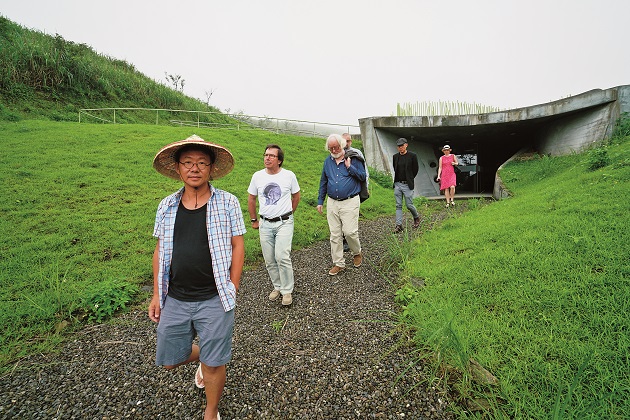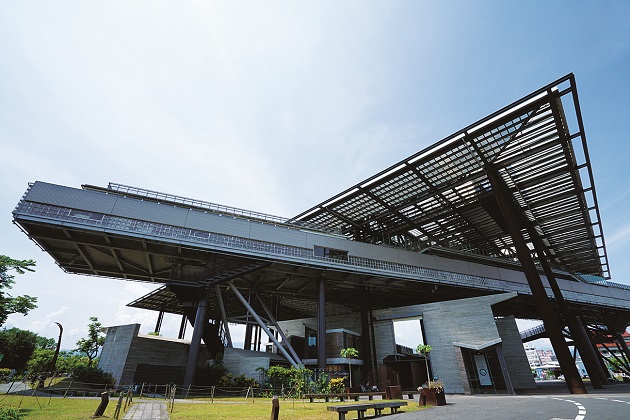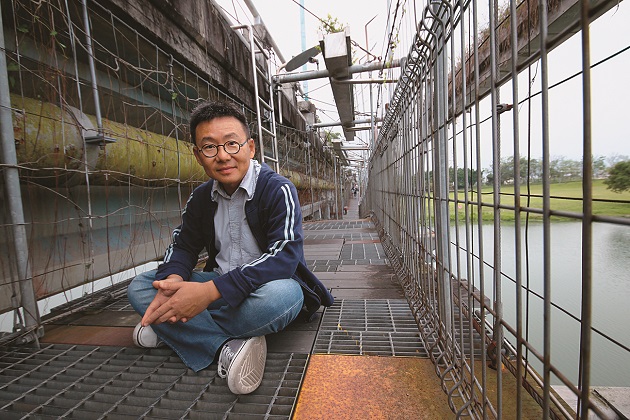FieldOffice Architects
Stunning Europe with Taiwanese Architectural Design

Source:CW
After over two decades of silently pioneering modern spatial design in rural Taiwan, FieldOffice Architects are drawing international attention this month, becoming the first Taiwanese architectural bureau to showcase their work in Europe.
Views
Stunning Europe with Taiwanese Architectural Design
By Hsiao-wen WangFrom CommonWealth Magazine (vol. 607 )
A leisurely walk through narrow cobblestone alleyways in the old part of Yilan City, past the Social Welfare Center with its eye-catching façade of red brick, grey cement and black cladding, will bring you to the scenic Jin-Mei Pedestrian Bridge across the green banks of the Yilan River. From the elevated boardwalk, pedestrians can admire the picturesque sunset in the evening.
When FieldOffice Architects founder Huang Sheng-yuan shows visitors from Japan, Europe and China around his chosen home city of Yilan, the bridge, completed in 2010, is one of the must-sees on his list.
Today, a group of prominent guests from abroad are attentively listening to Huang’s explanations of his work. They are Finnish architect Juhani Pallasmaa, a jury member of the 2014 Pritzker Architecture Prize, fellow Finnish architect Tommi Lindh, who serves as the director of the Alvar Aalto Foundation and Museum, Spaniard Alex Susanna i Nadal, director of the Institut Ramon Llull, which promotes the Catalan language and cultural heritage, as well as Estonian architect Triin Ojari, the director of the Museum of Estonian Architecture.
From October 6, Huang's FieldOffice Architects will showcase its works on a touring exhibition across several countries in Europe. The first leg of the tour will be the Alvar Aalto Museum in Finland. The exhibition will then travel to Estonia next January, Lithuania in March, and the Czech Republic in April, where it will be part of the International Festival of Architecture, Design and Arts in Ostrava. It will also be shown in Prague. The tour will come to a close in France with a final exhibition in Paris.
It is the first time that a Taiwanese architectural office has been invited to tour Europe with an exhibition.
For more than 20 years, the two dozen members of the FieldOffice Architects team have dedicated their efforts to improving the public space in rural Yilan County. Why does their work particularly resonate with Scandinavian and northern European architects? Do people see parallels to understated Scandinavian design? How has it attracted the attention of curators in the old cultural metropolises of Prague and Paris?
Luodong Cultural Working House
Huang takes Pallasmaa and his group on a walk on the premises of the Luodong Cultural Working House, which was built around an ancient lumber yard. With its flat latticework steel roof, the working house resembles a futuristic spaceship. One of its highlights is the 114-meter long sky walkway, which allows visitors to admire the scenic surroundings and gaze at the far horizon. The structure alludes to the importance of the timber industry in Luodong’s history. The view up into the steel roof creates the impression of watching from underwater as logs flow by on the water’s surface.
 Thanks to its futuristic design, the Luodong Cultural Workhouse has put the small town on the architectural map. It also provides plenty of public space for events and exhibitions.
Thanks to its futuristic design, the Luodong Cultural Workhouse has put the small town on the architectural map. It also provides plenty of public space for events and exhibitions.
A light breeze blows through the open, free-flowing space below, the beautiful scenery visible on all sides. Amid the chirping of crickets, a student band from Luodong High School rehearses for an evening gig on the workhouse's stage where one of their idols, Taiwanese pop star Jay Chou, has performed. Drawn by the wafting sounds of electric guitars, tourists in small groups wander curiously around.
"The longer you stay in Toyo Ito’s buildings, the more uncomfortable you feel. On the contrary, the longer you stay in Huang’s buildings, the more comfortable and relieved you feel,” notes the white-bearded Pallasmaa in comparing the two master architects.
”This building topples the hegemony of functionalism and formalism in architecture. It’s the people who define architecture they live and breathe within, not the architect,” remarks Susanna i Nadal.
The Workhouse reflects FieldOffice Architects’ consideration of the publicness of public space.
It took 14 years to build the Workhouse because it proved difficult to find an authoritative voice to define a space for the leisure and fun of Luodong’s citizens as county magistrates and top bureaucrats came and went in quick succession against the backdrop of a change of ruling parties in the central government. Four years ago, the Working House won FieldOffice Architects the Best Architecture Award at the 3rd Chinese Architecture Media Awards (CAMA) organized by the Southern Metropolis Daily in collaboration with several Chinese architectural magazines. The team’s independent, free style is also attracting admirers from China.
Young people from China and India flock to the architectural bureau, tucked away amid the lush fields of Yilan, to work alongside Huang. They want to learn how architecture can incorporate natural settings, flowing through the environment like water, rather than dominating the surroundings with grandiose design.
“Step by step, we muster our resolve to resist the tyranny of the eye and expertise. We need to communicate with the environment, relinquish ourselves to nature. For the past 21 years, FieldOffice Architects have not wavered in their resolve to reconcile the values of different generations in order to bring about peaceful coexistence,” explains Huang.
Pallasmaa admires FieldOffice Architects’ courage to resist “the tyranny of the eye.”
In his book The Eyes of the Skin, required reading for architectural students, Pallasmaa bemoans the bias in cognition resulting from the dominance of vision over the other senses. He writes: “The eye is the organ of distance and separation, whereas touch is the sense of nearness, intimacy and affection. The eye surveys, controls and investigates, whereas touch approaches and caresses.” When sight or vision takes precedence over other senses, our cities are strewn with emotionless and isolated skyscrapers. When touch is factored in, cities offer plentiful sensory experiences like plazas that allow for spontaneous interaction among citizens.”
“The experience of time and continuum is as essential in human life and architecture as space. Architecture enables us to dwell equally in time and space. Huang’s work suggests a continuum of time rather than termination,” remarks Pallasmaa in voicing his admiration for Huang’s work. The works of FieldOffice Architects challenge the inertia that is so commonly employed in current politics; everywhere they reveal the apt use of the passage of time and build dialogue and a spirit open to possibilities.
An Interminate Project
The Jin-Mei Pedestrian Bridge, which spans the Yilan River, is another FieldOffice Architects project where Huang “does not remember when it began, nor does he know how long it will last.”
Following never-ending consultations, the airy and graceful elevated boardwalk now peacefully coexists with a concrete car bridge that runs along its side. Suspended on a filigree of steel cables and bordered by steel railing, the boardwalk has been pieced together from seemingly randomly picked construction waste materials.
Sometimes a son takes his wheelchair-bound mother for a tour on the bridge to watch the dragon boats in action. Giggling and chattering from under the boardwalk reveals that children are happily playing on the swings below. The narrow walkway suspended from one side of the old bridge creates a space for random encounters between people and narrows the distance between them and the river.
 The Jin-Mei Pedestrian Bridge across the Yilan River runs alongside an existing concrete road bridge. The suspended boardwalk epitomizes the FieldOffice architectural philosophy of blending scenery with local life.
The Jin-Mei Pedestrian Bridge across the Yilan River runs alongside an existing concrete road bridge. The suspended boardwalk epitomizes the FieldOffice architectural philosophy of blending scenery with local life.
A narrower space brings people closer together.
Dimmed lighting will allow birds to find rest.
These were the initial ideas that Huang had in mind when he designed the Jin-Mei Pedestrian Bridge. “Actually, Mr. Huang didn’t have a complete picture in mind; he didn’t have a clear answer,” asserts architect Liu Chung-sheng of the Yilan-based Harmonious Architects & Planners. Liu is a student of Huang.
Liu learned at FieldOffice Architects that a building is not the work of an individual but gradually emerges from a dialogue that involves local residents, contractors, consultants and bureaucrats. An architect needs to be able to view time as a friend that helps him bring to paper the images that everyone has in mind.
The Luodong Cultural Working House took shape over a period of 14 years, the project Historical City Cultural Alley by Yilan Riverside was completed after over 13 years, and the Kamikaze Aircraft Shelter Museum in Yuanshan on a site from the Japanese colonial era took eleven years to complete.
In order to relate to the past and consider the future, Huang believes in keeping his plans flexible, leaving space to be gradually filled in the future.
Visitors to the FieldOffice Architects bureau often ask many questions, some of which yield surprising answers.
“How does the Jiaoxi Household Registration Office not have any straight corner or straight lines?” asks Lindh as he looks at the respective architectural model. “Oh, that’s because it isn’t a building, it is a mountain,” replies Huang.
Susanna i Nadal wants to know how many employees the office has. “Do you mean now, at the present stage?” Huang replies. “I don’t know, people come and go, you need to ask them to get a more precise answer,” Huang says, pointing at the young people in the office.
The easy-going Huang does, however, have a picture in his mind. “If I spell this out, project owners will be afraid; I am not sure whether I should divulge this secret,” says Huang. However, he can’t help but admit, "We have already figured out how every single FieldOffice project will disappear.“
Cherry Orchard Cemetery
Seeing Taiwan’s Past and Future
The Cherry Orchard Cemetery is the most beautiful resting place in Taiwan.
The rugged, curved flyover bridge that forms the entrance to the cemetery spans an entire valley. Shrouded in mist, the bridge entices visitors to stop and listen to the trickling sound of the mountain creek below.
Huang likes to take his visitors down to the creek to let them see Taiwan from a fresh perspective. “Now we are standing at the highest point of the Lanyang Plain river delta, where three rivers meet. Facing the Pacific Ocean and backed by the central mountain range, the Xueshan Range, you can see Taiwan’s past and future,” notes Huang, who sometimes sounds like a poet or a philosopher.
At the highest point of the cemetery, on a vast expanse of greenery stands a sepulchral stele without inscription – this is the resting place of Taiwanese political reformer, social activist and anti-colonialist Chiang Wei-shui. Huang considers the relocation of Chiang’s remains from Taipei to the cemetery on Yilan’s Wei-shui Hill as his most daring experiment.
Fortunately, Chiang's descendants agreed to the idea.
“This cemetery is very minimalist, even by Nordic aesthetic standards,” remarks Ojari.
The party walks across the grave, which is covered with lush grass. There is no authoritarian terror, only democratic closeness. No inscription pays tribute to the renowned physician and political figure from the Japanese colonial period. Only a short excerpt from a “clinical lecture” that highlights Chiang’s ideal that “a good doctor heals the country” has been set into a low stone wall.
When one turns around after arriving at the visitor center, the entire cemetery resembles undulating hills. “In thirty years, these places will be overgrown. While they exist, you also need to figure out how they will eventually disappear,” Huang tells his visitors.
“There’s a sweet melancholy,” Pallasmaa says suddenly as the group walks around between the urn towers in drizzling rain. The cemetery brought to his mind the morning when his father left the family to fight in World War II. Pallasmaa, then only three years old, was sitting on the dining table, feet dangling over the table as he said good-bye, thinking that his father would return home the next day.
At the borderline between life and death, Huang’s Cherry Orchard Cemetery makes people calmly think that probably only time can bear witness to time.
Huang likes to say that once people stand on a roof, they easily gain new insights. The FieldOffice Architects projects make it easy for people to walk up to the roof, leave their familiar locations and stand on the highest point of another system. Then they suddenly realize that a point of view involves a process of looking into the distance from a high place, and that history is space that can be lengthened or shortened.
How can the FieldOffice Architects touring exhibition, with its emphasis on quiet autonomy, dialogue with people and time as a friend, inspire Europe?
Pallasmaa says, “Huang has expanded the role of the architect further than any architect today that I know.” He points out that the typical Western architect is a professional who works in an office for remuneration. But Huang works across different fields of expertise to realize projects that improve life in the countryside, communicating with bureaucrats, residents, project owners and financiers as a “proactive participant or even a social activist,” explains Pallasmaa.
To underline his point, the 80-year-old veteran architect, who has seen the work of countless Pritzker Prize laureates, quotes Nobel Prize winning poet Joseph Brodsky as saying: “‘The poet does not accumulate expertise, he collects uncertainties.’ So does a true architect,” posits Pallasmaa.
After 23 years of dedicated work, Huang will take the masterpieces that he has built against the backdrop of Yilan’s blue mountain range to the snow-capped Scandinavian Peninsula, hot-blooded Spain, Prague in spring and Paris in the summer.
With the FieldOffice Architects touring exhibition, Taiwan is not only sending its business card out to the world, but also a letter of invitation with the message: We would like to invite the world to join Yilan and Taiwan in overcoming constraints, surpassing the here and now and side with freedom.
Translated from the Chinese by Susanne Ganz






